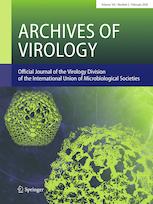View Item
- xmlui.general.dspace_homeCentros e Institutos de InvestigaciónCIAP. Centro de Investigaciones AgropecuariasInstituto de Patología VegetalArtículos científicosxmlui.ArtifactBrowser.ItemViewer.trail
- DSpace Home
- Centros e Institutos de Investigación
- CIAP. Centro de Investigaciones Agropecuarias
- Instituto de Patología Vegetal
- Artículos científicos
- View Item
Exploring the tymovirales landscape through metatranscriptomics data
Abstract
Tymovirales is an order of viruses with positive-sense RNA genomes that mostly infect plants, but also fungi and insects. The number of genome sequences of viruses that could fit this taxon has been growing in the last few years with the extensive use of high-throughput sequencing. Here, we report the discovery of 31 novel viral genome sequences associated with 27 different host plant species, which were hidden in public databases. These viral sequences
[ver mas...]
Tymovirales is an order of viruses with positive-sense RNA genomes that mostly infect plants, but also fungi and insects. The number of genome sequences of viruses that could fit this taxon has been growing in the last few years with the extensive use of high-throughput sequencing. Here, we report the discovery of 31 novel viral genome sequences associated with 27 different host plant species, which were hidden in public databases. These viral sequences were identified through homology searches in more than 3,000 plant transcriptomes from the NCBI Sequence Read Archive (SRA) using known tymovirales sequences as queries. Identification, assembly, and curation of raw SRA reads resulted in 29 viral genome sequences with complete coding regions, and two representing partial genomes. Some of the obtained sequences highlight novel genome organizations for members of the order. Phylogenetic analysis showed that six of the novel viruses are related to alphaflexiviruses, 17 to betaflexiviruses, two to deltaflexiviruses, and six to tymovirids. These findings shed new light on the phylogenetic relationships and evolutionary landscape of this group of viruses. Furthermore, this study illustrates the complexity and genome diversity among members of the order and demonstrates that analyzing public SRA data provides an invaluable tool to accelerate virus discovery and refine virus taxonomy.
[Cerrar]

Fuente
Archives of Virology (Published: 16 June 2022)
Date
2022-06-16
Editorial
Springer
ISSN
0304-8608
1432-8798 ( online)
1432-8798 ( online)
Formato
pdf
Tipo de documento
artículo
Palabras Claves
Derechos de acceso
Restringido
 Excepto donde se diga explicitamente, este item se publica bajo la siguiente descripción: Creative Commons Attribution-NonCommercial-ShareAlike 2.5 Unported (CC BY-NC-SA 2.5)
Excepto donde se diga explicitamente, este item se publica bajo la siguiente descripción: Creative Commons Attribution-NonCommercial-ShareAlike 2.5 Unported (CC BY-NC-SA 2.5)

